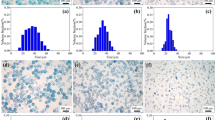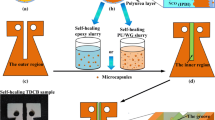Abstract
Smart self-healing coatings have been attracting tremendous interest due to their capability for preventing crack propagation in the protective coatings by releasing active agents like isocyanate molecules from micro/nanocapsules. The quality of healed area and subsequent use of the healed coated module are directly related to the chemical composition of healing agent. Faster curing rate and more appropriate physical properties were anticipated for moisture curing of bulky isocyanate molecules than the low molecular weight monomeric analogous. For practical utilization of these advantages, encapsulation of such bulky isocyanate molecules was considered in this work. To this end, optimized preparation and characterization of novel single-layer polyurethane-type microcapsules, richly and efficiently loaded with bulky isocyanate molecules is described. This healing agent was prepared through the reaction of excess amount of isophorone diisocyanate (IPDI) with 2-ethyl-2-hydroxymethyl-1,3-propanediol (TMP). The healing agent was then encapsulated with a polyurethane shell via an oil-in-water (O/W) emulsion polymerization technique. The mixing rate and surfactant concentration were altered to optimize the size and shell thickness of the microcapsules. The prepared microcapsules were very stable after 10 months, and they just lost less than 7 wt% of their loaded isocyanate molecules. The microcapsules were loaded into an epoxy-based coating and the crack healing efficiency of incorporated healing agent was clearly recorded. Microcapsules containing monomeric IPDI were also prepared and crack healing efficiency of these two healing agents regarding crack healing was compared.










Similar content being viewed by others
References
Trask R, Williams H, Bond I (2007) Self-healing polymer composites: mimicking nature to enhance performance. Bioinspir Biomim 2:1–12
Wu DY, Meure S, Solomon D (2008) Self-healing polymeric materials—a review of recent developments. Prog Polym Sci 33(5):479–522
Ghosh S (2009) Self-healing materials: fundamentals, design strategies, and applications. Wiley, Weinheim
Blaiszik BJ, Kramer SLB, Olugebefola SC, Moore JS, Sottos NR, White SR (2010) Self-healing polymers and composites. Annu Rev Mater Res 40:179–211
Ji Xiaofan, Huang Feihe (2015) A rapidly self-healing supramolecular polymer hydrogel. J Mater Sci 58(3):436–437. doi:10.1007/s11426-015-5338-5
Pang JWC, Bond IP (2005) A hollow fiber reinforced polymer composite encompassing self-healing and enhanced damage visibility. Compos Sci Technol 65(11–12):1791–1799
Trask R, Bond I (2006) Biomimetic self-healing of advanced composite structures using hollow glass fiber Smart. Mater Struct 15:704–710
Williams H, Trask R, Bond I (2007) Self-healing composite sandwich structures. Smart Mater Struct 16(4):1198–1207
Bejan A, Lorente S, Wang KM (2006) Networks of channels for self-healing composite materials. J Appl Phys 100(033528):1–6
Toohey K, Sottos N, Lewis J, Moore J, White S (2007) Self-healing materials with microvascular networks. Nat Mater 6:581–585
Park JH, Braun PV (2010) Coaxial electrospinning of self-healing coatings. Adv Mater 22:496–499
White SR, Sottos NR, Geubelle PH, Moore JS, Kessler MR, Sriram SR, Brown EN, Viswanathan S (2001) Autonomic healing of polymer composites. Nature 409:794–797
Lewis G, Wellborn B, Jones L, Biggs P (2009) A room-temperature autonomically-healing PMMA bone cement: influence of composition on fatigue crack propagation rate. J Appl Biomater 7:90–96
Jackson AC, Bartelt JA, Marczewski K, Sottos NR, Braun PV (2011) Silica-protected micron and sub-micron capsules and particles for self-healing at the microscale. Macromol Rapid Commun 32:82–87
Coope TS, Mayer UFJ, Wass DF, Trask RS, Bond IP (2011) Self-healing of an epoxy resin using scandium (III) triflate as a catalytic curing agent. Adv Funct Mater 21:4624–4631
Lee J, Bhattacharyya D, Zhang MQ, Yuan YC (2011) Fracture behaviour of a self-healing microcapsule-loaded epoxy system. Express Polym Lett 5(3):246–253
Cho SH, White SR, Braun PV (2009) Self-healing polymer coatings. Adv Mater 21(6):645–649
Yang J, Keller MW, Moore JS, White SR, Sottos NR (2008) Microencapsulation of isocyanates for self-healing polymers. Macromolecules 41:9650–9655
Huang M, Yang J (2011) Facile microencapsulation of HDI for self-healing anticorrosion coatings. J Mater Chem 21:11123–11130
Huang M, Yang J (2014) Salt spray and EIS studies on HDI microcapsule-based self-healing anticorrosive coatings. Prog Org Coat 77:168–175
Khun NW, Sun DW, Huang MX, Yang GL, Yue CY (2014) Wear resistant epoxy composites with diisocyanate-based self-healing functionality. Wear 313:19–28
Credico BD, Levi M, Turri S (2013) An efficient method for the output of new self-repairing materials through a reactive isocyanate encapsulation. Eur Polym J 49:2467–2476
Wang W, Xu L, Liu F, Li X, Xing L (2013) Synthesis of isocyanate microcapsules and micromechanical behavior improvement of microcapsule shells by oxygen plasma treated carbon nanotubes. J Mater Chem A 1:776–782
Wang W, Xu L, Li X, Yang Y, An E (2014) Self-healing properties of protective coatings containing isophorone diisocyanate microcapsules on carbon steel surfaces. Corros Sci 80:528–535
Nguyen LT, Hillewaere XKD, Teixeira RFA, Berg OVD, Prez FED (2015) Efficient microencapsulation of a liquid isocyanate with in situ shell functionalization. Polym Chem 6:1159–1170
Biliet S, Hillewaere XKD, Teixeira RFA, Du Prez FE (2013) Chemistry of crosslinking processes for self-healing polymers. Macromol Rapid Commun 34:290–309
Cheong IW, Kim JK (2004) Synthesis of core–shell polyurethane–urea nanoparticles containing 4,40-methylenedi-p-phenyl diisocyanate and isophorone diisocyanate by self-assembled neutralization emulsification. Chem Commun 21:2484–2485
Kessler MR, Mauldin TC, Hondred PR, Ding R (2011) Biorenewable polymers and composites with self-healing functionality. 18th International conference on composite materials
Mishra AK, Narayan R, Raju KVSN (2012) Structure-property correlation study of hyper branched polyurethane-urea (HBPU) coatings. Prog Org Coat 74(3):491–501
Kantheti S, Sarath PS, Narayan R, Raju KVSN (2013) Synthesis and characterization of triazole rich polyether polyols using click chemistry for highly branched polyurethanes. React Funct Polym 73:1597–1605
Shaffer MW. In: ICE 2004 technology conference, Chicago, Oct 25–29, 2004
Ni P, Zhang M, Yan N (1995) Effect of operating variables and monomers on the formation of polyurea microcapsules. J Membr Sci 103(1–2):51–55
Kumar A, Stephanson L, Murry J (2006) Self healing coatings for steel. Prog Org Coat 55(3):244–253
Finken R, Seifert U (2006) Wrinkling of microcapsules in shear flow. J Phys 18:185–191
Murphy EB, Wudl F (2010) The world of smart healable materials. Prog Polym Sci 35:223–251
Brown EN, Kessler MR, Sottos NR, White SR (2003) In situ poly(urea-formaldehyde) microencapsulation of dicyclopentadiene. J Microencapsul 20:719–730
Rallison JM (1984) The deformation of small viscous drops and bubbles in shear flow. Annu Rev Fluid Mech 16:45–66
Kuo YM, Wu CT, Wu WH, Chao DY (1994) Effect of surfactants on the particle sizes of red 170 polyurea microcapsules. J Appl Polym Sci 52:1165–1173
Yoshizawa H, Kamio E, Hirabayashi N, Jacobson J, Kitamura Y (2004) Membrane formation mechanism of cross-linked polyurea microcapsules by phase separation method. J Microencapsul 21:241–249
Tcholakova S, Denkov ND, Danner T (2004) Role of surfactant type and concentration for the mean drop size during emulsification in turbulent flow. Langmuir 20:7444–7458
Behzadnasab M, Esfandeh SM, Mirabedini MJ, Zohuriaan-Mehr RR (2014) Farnood, preparation and characterization of linseed oil-filled urea-formaldehyde microcapsules and their effect on mechanical properties of an epoxy-based coating. Colloids Surf A 457:16–26
Huang M, Yang J (2011) Facile microencapsulation of HDI for self-healing anticorrosion coatings. J Mater Chem 21:11123–11130
Acknowledgement
The authors would like to acknowledge Iran Polymer and Petrochemical Institute for the financial support during the course of this research.
Author information
Authors and Affiliations
Corresponding author
Rights and permissions
About this article
Cite this article
Haghayegh, M., Mirabedini, S.M. & Yeganeh, H. Microcapsules containing multi-functional reactive isocyanate-terminated polyurethane prepolymer as a healing agent. Part 1: synthesis and optimization of reaction conditions. J Mater Sci 51, 3056–3068 (2016). https://doi.org/10.1007/s10853-015-9616-6
Received:
Accepted:
Published:
Issue Date:
DOI: https://doi.org/10.1007/s10853-015-9616-6




